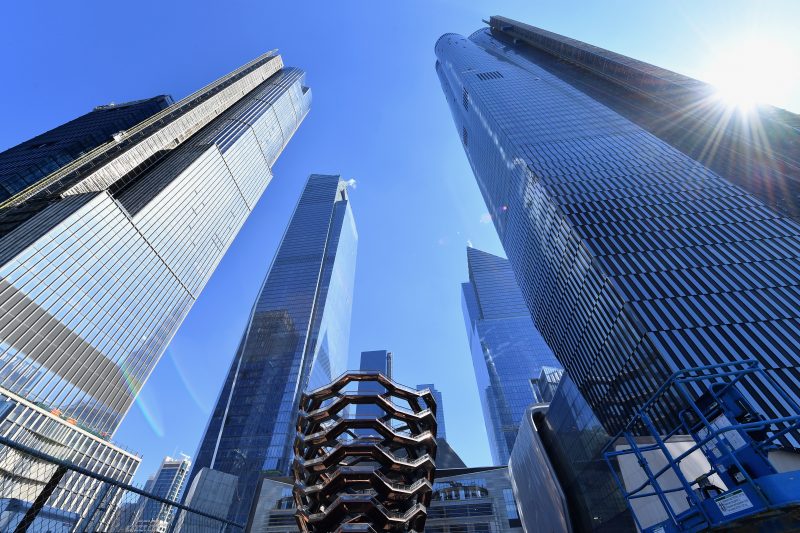New York’s controversial Hudson Yards complex set to open
It took seven years and $16 billion to build Hudson Yards, a project erected over a New York train depot (Angela Weiss)
New York (AFP) – With an arts center, posh stores, uber expensive apartments and lots of controversy, the largest privately funded real estate development in US history opens Friday in Manhattan.
It’s in a place called Hudson Yards, and it took seven years and a cool $16 billion to build.
The project was erected on a giant slab of concrete covering a rail depot and makes New York a new center of urban planning innovation in a city with a red hot real estate market.
In this new neighborhood, some apartments will fetch as much as $30 million.
The area between 10th and 12th avenues and 30th and 40th streets was long a no-man’s land. Now it is ready to welcome New Yorkers and tourists in a new tribute to the US financial capital’s legendary skyscrapers.
The six towers in this development, conceived by prestigious architects in the 2000s when Michael Bloomberg was mayor, did not set a record for height.
But they are brimming with technological innovation. The complex has its own waste treatment, a blackout-proof electrical generating system and automatic underground doors to protect sensitive equipment from rising waters as a result of climate change.
– A new New York icon? –
The project’s goal is not just to use idle space in a city that is fabulously dense and crowded. Rather, the idea is for the neighborhood to be fully integrated into the Big Apple, said Douglas Woodward, a professor of architecture at Columbia University who took part in the design master plan.
Aside from the residential towers and offices — which already host corporate offices of companies like L’Oreal USA and software company SAP — the complex has about 100 high-end stores like Dior and Fendi, and 25 restaurants from big-name chefs like Jose Andres and Thomas Keller.
It also has an artistic center named The Shed that will open in April, and an outdoors area with trees to create a campus atmosphere, Woodward said.
Unlike London’s Canary Wharf neighborhood, which is far from the city center, or La Defense, located west of Paris, Hudson Yards is just a few minutes from Times Square thanks to a subway station that opened in 2015.
The neighborhood can also be reached by foot via the High Line, a raised walkway built on a former rail line that in just a few years has become a major city attraction.
Stephen Ross, the real estate developer behind the project, wants Hudson Yards — said to be the city’s most ambitious since Rockefeller Center was built in the 1930s — to become “the biggest tourism attraction and icon in New York.”
Despite the inherent risk of such a massive investment, and the fact that many of the apartments are still available for rent — with a single room apartment going for $5,000 a month — the 78-year-old real estate magnate is brimming with confidence and said he will soon move to a Hudson Yards penthouse.
“What we are doing here is so unique” that residents “will want to be here,” Ross said during a recent visit to the work site. “People want to live in a place where everything is, that’s what people live in a city for.
“It’s a live-work-play environment, and you are in the city! This does not exist anymore,” he said.
– Chorus of critics –
Not everyone is as enthusiastic.
“I can’t help feeling like an alien here, as though I’ve crossed from real New York with all its jangling mess into a movie studio’s backlot version,” New York magazine architecture critic Justin Davidson wrote in February.
“Everything is too clean, too flat, too art-directed.”
Davidson slammed Hudson Yards as “para-Manhattan,” a site that has “no history, no holdover greasy spoons, no pockets of blight or resident eccentrics.”
At a time of growing outrage over tax breaks given to big companies such as Amazon, some are angered by the subsidies and tax breaks granted to the project, estimated at around $6 billion.
Critics have especially focused on “The Vessel,” a giant open air spiral staircase that climbs 15-stories high located in the plaza between the building towers.
Visitors can climb the structure via 154 different staircases after making a free online reservation.
When the project was presented in 2017, The New York Times dubbed it the “stairway to nowhere.”
But as is the case of many great building projects, the final verdict will be given by its use.
One of Hudson Yards’s coming attractions is an observation deck that seems to float more than 1,000 feet (300 meters) above ground.
The observation deck, attached to a 1,296-foot tower (the Empire State Building’s needle is 1,250 feet tall), will not open until 2020.
The project’s second phase is just about to begin. A more residential-type neighborhood will be built on the west side of the rail depot, complete with a school and green areas.
One thing is certain: fueled by the city’s dynamic economy, building projects are booming in New York, east and west of Manhattan, on “billionaires row” that borders Central Park and in Queens, where plans are underway for a project at Sunnyside Yard, an old rail depot even bigger than Hudson Yards.
Disclaimer: This story is published from a syndicated feed. Siliconeer does not assume any liability for the above story. Validity of the above story is for 7 Days from original date of publishing. Content copyright AFP.


